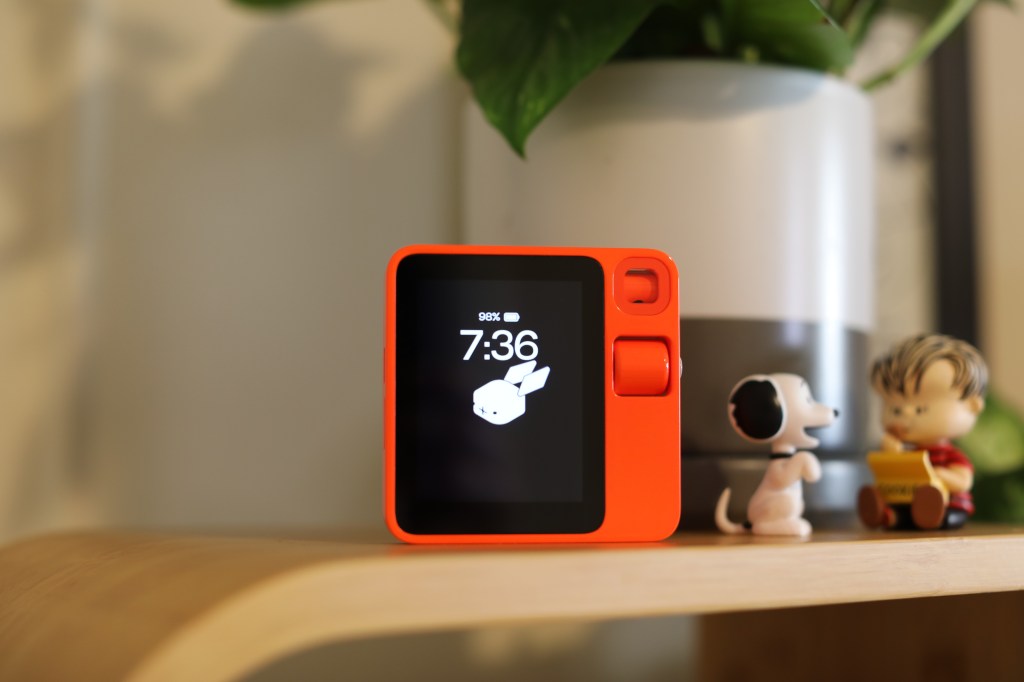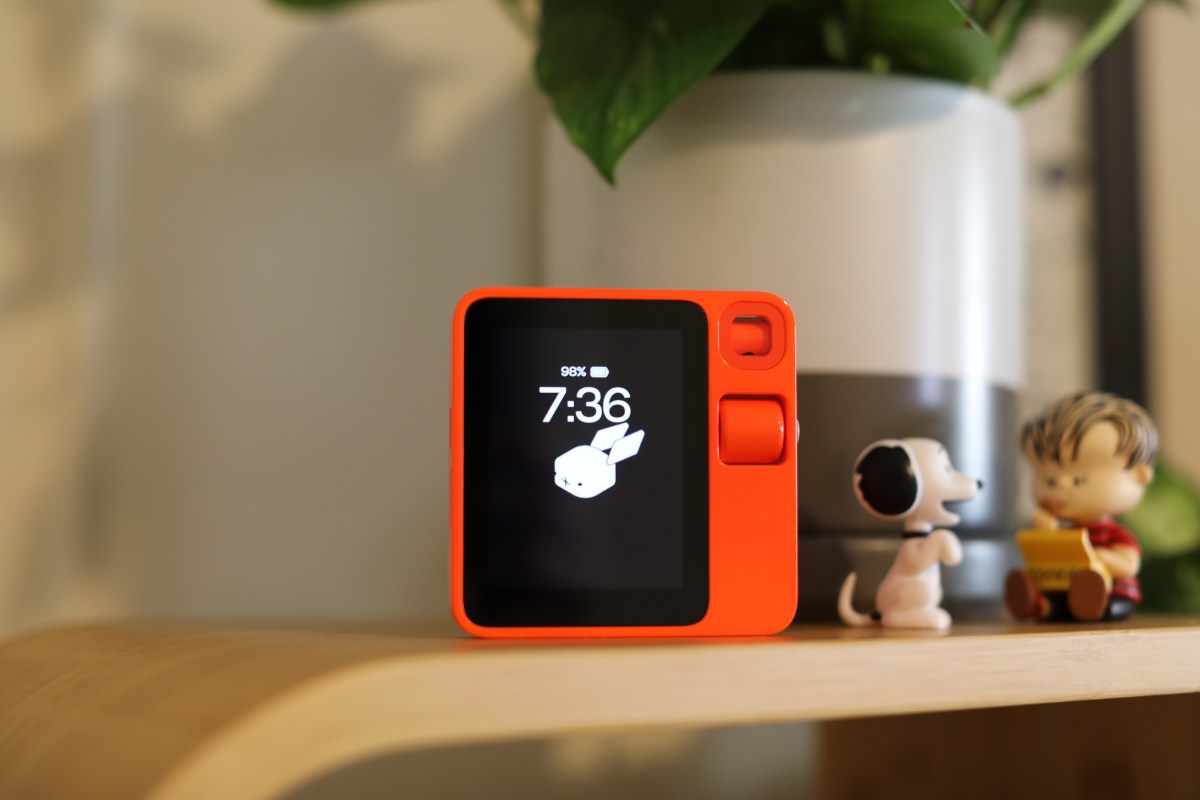
Image credits: Brian heater
If there’s one takeaway from last night’s Rabbit R1 launch event, it’s this: Hardware can be fun again. After a decade of the undisputed dominance of smartphones, there is, once again, enthusiasm to find consumer electronics. The wisdom and longevity of any individual product or form factor – while important – can be set aside for a moment. Just sit back and enjoy the show.
Despite flying out of an airport on a monthly basis, last night was my first night at the TWA Hotel, nestled among the labyrinthine grounds of JFK’s Terminal 5. After all, one rarely stays in the hotels where one lives. The space is a nod to another era, when people dressed to board flights and smiling chefs carved whole legs of ham.

Image credits: Brian heater
A rented DeLorean emblazoned with Rabbit branding was parked out front, serving as a postmodern homage to the event’s agnostic embrace of the past. Less bright was the Ritchie Valens song set among Motown hits on the elevator speakers as we rode three stories down into the underground event space.
Hundreds of attendees were already lined up by the time I arrived at the space. Familiar faces from the world of tech journalism were talked about, but a significant number were excited early adopters. Both groups were distinguished respectively with “Press” and “VIP” rope. A man standing in front of me in line volunteered that he had flown from Los Angeles especially for the event.
Like Humane, the Rabbit team is clearly invested in the spectacle. The approaches are similar but different, with the former investing a good chunk of funds into viral videos, including an eclipse teaser which clearly fancied itself some sort of spiritual successor to Apple’s famous “1984” spot. However, it’s understood that Rabbit really didn’t anticipate how much buzz the company’s debut at CES 2024 would create.
“When we started building the r1, we said internally that we’d be happy if we sold 500 devices on launch day,” the company posted on X. “In 24 hours, we already beat him by 20 times!”
It would have been difficult to time the release better. The generative AI hype had reached a fever pitch. Humane had discovered but had not yet released his Ai pin. Intel was declaring 2024 the year of the AI computer and soon Samsung would do the same for the smartphone. Apple, meanwhile, was promising its own big news on that front in the coming months.

Image credits: Brian heater
When putting on a big show, a tech company also needs to dress the part. The focus on product design is another key parallel between Rabbit and Humane. While the form factors are very different, both the Pini Ai and the R1 are testaments to the value of industrial design. For its part, Rabbit took a page out of the Nothing playbook, contracting the execs of Teenage Engineering to create a wildly original-looking product. Indeed, the R1 looks as much a work of art as anything else. It’s a squat, orange object – something you might want to mount to the handlebars of your bad-weather bike.
While the Ai Pin’s defining physical characteristic is its lack of a screen, the Rabbit embraces the screen – even modestly. The screen is a mere 2.88 inches and at times looks almost random because of it. This goes double for its touch functionality. While, like the Ai Pin, a large portion of your interactions are done with voice, an analog rotary and button combo mostly fills in the gaps.
Beyond entering a Wi-Fi password, there’s not much reason to touch the screen. This is for the best. The most monumental and ongoing task facing the nascent device AI space is justifying its existence outside of the smartphone. After all, anyone with a half-decent (and very crappy) mobile device has access to generative AI models. These are mostly accessed through browsers or stand-alone apps at the moment, but models like ChatGPT and Google Gemini will increasingly be embedded in mobile operating systems in the coming months and years.

Image credits: Brian heater
When I asked Humane the question, co-founder and CEO Bethany Bongiorno offered the following anecdote:[Humane’s co-founders] had gone to this dinner and a family was sitting next to us. There were three kids and a mom and dad, and they were on the phone all the time. It really started a conversation about the incredible tool we built, but also some of the side effects.”
Ai Pin’s lack of display is, essentially, a feature. Again, there’s plenty of reason to question the wisdom and efficacy of that design decision, but regardless, it’s crucial to the product. It’s worth noting that at $199, the price justification barrier is significantly lower than the Ai Pin’s asking price.

Brian heater
The truth is, at this early stage of the first generation, novelty is a massive selling point. You either see the appeal of a dedicated LLM accessing device or you don’t. Rabbit’s relatively affordable price opens up this world quite a bit. You should also note that R1 does not require a monthly service fee, while Humane charges you $24 per month for functionality. That, coupled with the touchscreen (albeit limited) and truly stellar design, and you can see why the product has taken some of the wind out of Ai Pin’s sails.
Neither device sells apps like modern smartphones do. You interact exclusively with the operating system on board. However, this can be linked to other accounts, including Spotify, Uber, Midjourney and DoorDash. The system can receive voice recordings and make two-way translations. The system can also acquire environmental context via the onboard camera.
Among the first tests I did was to provide a description of my bookshelf. I pointed the camera at a row of four hardcovers: “Moby Dick” by Herman Melville; “The Barbary Coast” by Herbert Asbury; “Understanding Media” by Marshall McLuhan; and “Dodsworth” by Sinclair Lewis. Universal struggled with the last book – understandably so, as it was the least obvious of the bunch.
He mostly recognized and understood what he was seeing with “Moby Dick,” calling it a “classic” and sometimes offering a brief synopsis. He recognized the two middle books 50% to 75% of the time. He also tried to provide context in terms of curatorial choices and sometimes went out of his way to compliment said curation.
However, there were times when the context was a bit much. I asked R1 when the Oakland A’s are playing (I added the city after an initial investigation that only “A” showed up as “Ace”) and it gave me tonight’s game time, before opening a list of 10 or next 10 i.e. the teams playing. But hey, I’m a lifelong A’s fan. I enjoy such losses.

Image credits: Brian heater
Something worth noting about all these early writings is that these types of devices are designed to improve and customize the results the more you use them. I am writing this after receiving the device just last night. I will send it to Devin for a more in-depth write up.
Having only played with the R1 for a few hours, I can definitely tell you that it’s a more accessible device than the Humane Pin, thanks to the touchscreen and the price. It doesn’t solve the cultural obsession of the screen that Humane cares about – nor does it seem to aim for such grandiose ambitions in the first place. Rather, it’s a beautifully designed product that offers a compelling insight into where things might be headed.
